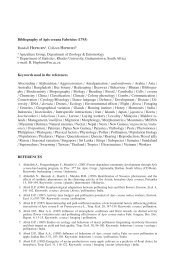H. Randall Hepburn, Colleen - Apidologie
H. Randall Hepburn, Colleen - Apidologie
H. Randall Hepburn, Colleen - Apidologie
Create successful ePaper yourself
Turn your PDF publications into a flip-book with our unique Google optimized e-Paper software.
38<br />
823. Swaminathan R., Bharadwaj S.C. (1998) Role of insect pollinators in seed setting of sunflower (Helianthus<br />
annuus L.) at Udaipur, Rajasthan, India, Indian Bee J. 60, 155−156. Keywords: dorsata / India / bee botany.<br />
824. Syed I.H. (1972) Morphological studies of the larva of Apis dorsata, Pak. J. Zool. 4, 69−71. Keywords:<br />
dorsata / brood / Pakistan.<br />
825. Sylvester H.A., Wongsiri S. (1993) DNA analysis of genetic variation in Asian honey bees, in: Connor L.J.,<br />
Rinderer T.E., Sylvester H.A., Wongsiri S. (Eds.), Asian Apiculture, Wicwas Press, Cheshire, pp. 156−160.<br />
Keywords: cerana / biochemistry / organic chemistry / dorsata / honey / genetics / Thailand / classification /<br />
workers.<br />
826. Szabo T.I. (1988) Sri Lanka: the bee paradise, Am. Bee J.128, 405−409. Keywords: beekeeping / cerana /<br />
dorsata / Sri Lanka.<br />
827. Takahashi J.I., Nakamura J. (2003) A scientific note on levels of polyandry of 2 queens of the Himalayan giant<br />
honeybee, Apis laboriosa, <strong>Apidologie</strong> 34, 191−192. Keywords: laboriosa / Nepal / reproduction / queens.<br />
828. Tam D.Q., Dung P.X. (1996) Introduction of Vietnam apiculture, Proc. 3rd Asian Apic. Assoc. Conf., Hanoi,<br />
pp. xvii-xxiv. Keywords: beekeeping / cerana / dorsata / honey / disease / pests / predators / Vietnam / combs.<br />
829. Tam D.Q. (2001) Honey marketing in Vietnam, Proc. 27th Int. Apic. Congr., Durban, CD-ROM. Keywords:<br />
beekeeping / cerana / dorsata / honey / Vietnam.<br />
Tam D.Q., Niem N.V., Trung L.Q., Dau T.T., Chinh P.H., Long L.T. (Eds.) (2005) Publications of Vietnam<br />
Bee Research 1990 – 1999, Bee Research and Development Center, Hanoi. Keywords: beekeeping / behaviour<br />
/ cerana / disease / pests / predators / dorsata / genetics / laboriosa / reproduction / Vietnam.<br />
830. Tan N.Q., Mardan M.B., Thai P.H., Chinh P.H. (1996) Some reproductive biology of Apis dorsata, Proc. 3rd<br />
Asian Apic. Assoc. Conf., Hanoi, pp. 15−22. Keywords: general biology / dorsata / drones / reproduction /<br />
Vietnam.<br />
831. Tan N.Q., Chinh P.H., Thai P.H., Mulder V. (1997) Rafter beekeeping with Apis dorsata: some factors affecting<br />
the occupation of rafters by bees, J. Apic. Res. 36, 49−54. Keywords: beekeeping / dorsata / Vietnam.<br />
832. Tan N.Q., Mardan M.B., Thai P.H., Chinh P.H. (1999) Observations on multiple mating flights of Apis dorsata<br />
queens, <strong>Apidologie</strong> 30, 339−346. Keywords: dorsata / foraging / reproduction / queens.<br />
833. Tan N.Q. (2004) Social-economic factors in traditional rafter beekeeping with Apis dorsata in Vietnam, Bee<br />
World 83, 165−170. Keywords: beekeeping / dorsata / Vietnam.<br />
834. Tanaka H., Suka T., Roubik D.W., Mohamed M. (2001) Genetic differentiation among geographic groups<br />
of three honey bee species, Apis cerana, A. koschevnikovi and A. dorsata in Borneo, Nature Hum. Activ. 6,<br />
5−12. Keywords: biogeography / Borneo / cerana / dorsata / genetics / honey.<br />
835. Tanaka H., Suka T., Kahono S., Samejima, Mohamed M., Roubik D.W. (2003) Mitochondrial variation and<br />
genetic differentiation in honey bees (Apis cerana, A. koschevnikovi and A. dorsata) of Borneo, Tropics 13,<br />
107−117. Keywords: Borneo / cerana / dorsata / honey / genetics / classification.<br />
836. Tanda A.S. (1983) Assessing the role of honey bees in a field of Asiatic cotton (Gossypium arboreum L.),<br />
Am. Bee J. 123, 593−594. Keywords: cerana / dorsata / honey / India / bee botany.<br />
837. Tanda A.S. (1984) Bee pollination increases yield of 2 interplanted varieties of Asiatic cotton (Gossypium<br />
arboreum L.), Am. Bee J. 124, 539−540. Keywords: cerana / dorsata / India / bee botany.<br />
838. Tanda A.S. (1984) Foraging behaviour of three species of Apis on raya in relation to the sugar concentration<br />
in its nectar, Indian Bee J. 46, 5−6. Keywords: behaviour / cerana / dorsata / foraging / India / bee botany.<br />
839. Tandon R., Shivanna K.R., Mohan Ram H.Y. (2001) Pollination biology and breeding system of Acacia<br />
Senegal, Bot. J. Linn. Soc. 135, 251−262. Keywords: general biology / beekeeping / dorsata / India / bee<br />
botany.<br />
840. Tangjingjai W., Verakalasa P., Sittipraneed S., Klinbunga S., Lekprayoon C. (2003) Genetic differences between<br />
Tropilaelaps clareae and Tropilaelaps koenigerum in Thailand, <strong>Apidologie</strong> 34, 513−524. Keywords:<br />
dorsata / disease / pests / predators / Thailand.<br />
841. Tarpy D.R., Nielsen R., Nielsen D.I. (2004) A scientific note on the revised estimates of effective paternity<br />
frequency in Apis, Insectes Soc. 51, 203−204. Keywords: cerana / dorsata / laboriosa / reproduction.<br />
842. Tealdi C. (1988) Honeybees in Indonesia, Ape Nostra Amica 10, 16−19. (In Italian). Keywords: cerana /<br />
dorsata / Indonesia.<br />
843. Tealdi C. (1989) Bees in Malaysia, Ape Nostra Amica 11, 15−19. (In Italian). Keywords: dorsata / biogeography<br />
/ Malaysia.<br />
844. Tembhare D.B., Paliwal G.N. (1990) Cephalic neuroendocrine system on the rock honey-bee, Apis dorsata<br />
(F.) worker, Proc. 11th Int. Congr. IUSSI, Bangalore, pp. 137−138. Keywords: dorsata / India / physiology.




